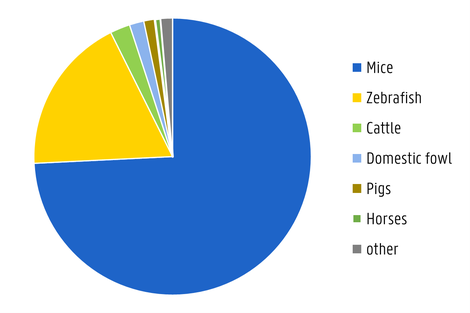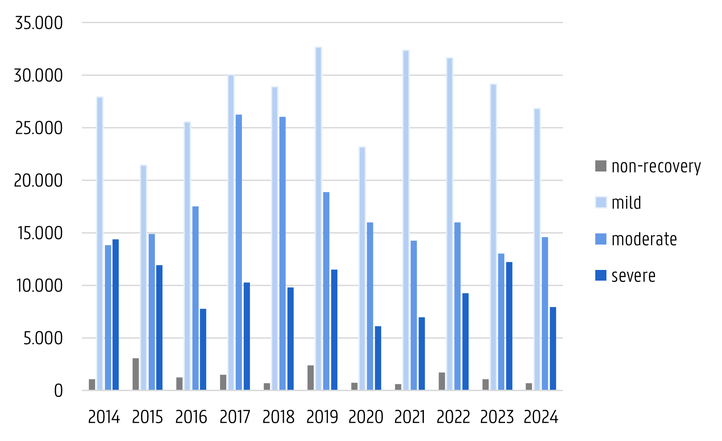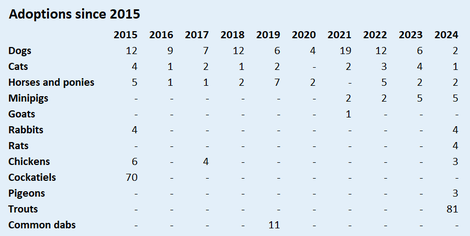Figures and statistics
In 2024, 49,977 animal experiments or other procedures involving animals were conducted at Ghent University. Since some animals were re-used (in accordance with the law), this is equivalent to 49,615 animals being used for experiments in 2024. An animal test, trial or experiment is defined by law as one experiment on one animal. For example, a study that uses 30 animals to take a single blood sample is counted as 30 animal experiments.
If you want to know where UGent stands in comparison with Flemish, Belgian and European figures over the years, you can compare the figures below with statistics provided by the Flemish service for animal welfare (in Dutch) and the European Union.
Numbers of animal experiments at Ghent University since 2014
The graph shows the numbers from 2014 onwards. The number of experiments in 2024 is the second lowest in the period 2014-2024 (after 2020, when the figures were affected by the Covid-19 pandemic). The number of animals being re-used in 2024 was close to the average of the previous years (362 versus 165 to 630 in the period 2014-2023).
Numbers per species
Annual fluctuations do not in themselves indicate any trend. For veterinary field studies with cattle and pigs, for example, the numbers fluctuate very strongly each year. This is caused by a limited number of studies in which relatively large numbers of animals are used in the context of disease monitoring or in the field of nutrition and welfare. The number of experiments with cattle was relatively high in 2024, the numbers of experiments with pigs and domestic fowl of 2024 were the lowest numbers since the start of the reporting.
The number of experiments with dogs, all in the context of veterinary medicine, was lower in 2024 than in all previous years. In cats, the number of experiments, also in the context of veterinary medicine, is about a quarter of the numbers of the past five years.
The number of experiments with zebrafish in 2024 is higher than in any of the previous years. This is the only figure where there is a clear upward trend. The number of experiments with mice is the lowest since 2017 (with the exception of 2020, the year of the Covid-19 pandemic). The number of experiments with rats shows a downward trend over the past ten years. In percentage terms, the number of experiments with mice remains relatively unchanged, making up about 75% of animal experiments. Ghent University does not conduct experiments with monkeys.
1 Re-use refers to the number of animals that were used previously in another test. There are strict rules governing re-use (cf. severity rate, see welfare of laboratory animals).
Numbers related to research aim
In many cases, animal research is conducted with an eye to direct or indirect application for human health. In 2024, for example, this was true of more than 98% of experiments using mice. The primary aim of research using rats and zebrafish is also to expand knowledge about humans and human health (resp. 99 and 100%).
Research with most other animal species, in contrast, is aimed at acquiring knowledge about the welfare of the animals. This is true, for example, for all experiments conducted using cattle, horses or cats in the context of research during the period 2014-2024. In the case of dogs this is true for 99.64% of experiments conducted over the same period; since 2019 this is 100%.
People often forget that veterinary medicine also draws heavily on insights from human medicine. The two areas of expertise cannot be completely separated from each other.
In the context of training, experiments are also often indirectly focused on animal welfare. This applies to mammals in particular. When veterinary students practice skills for palpation and handling of horses, this is also reported as animal experiments. These activities are therefore also assessed by the Ethics Committee, and are included in the annual figures as well. You can read more about the use of laboratory animals in the context of training.
The use of animals at Ghent University changes slightly over the years, in line with the evolution of research projects and disciplines. The main research themes at UGent, in terms of animal experiments in 2024, are (in ascending order) musculoskeletal diseases, cardiovascular diseases, gastrointestinal diseases, multisystemic disorders, immune disorders, and, by far, the research on cancer, accounting for almost 24% of the number of animal experiments in 2024.
Degrees of severity
According to the law, animal experiments or ‘tests’ refer to procedures and practices that are likely to cause as much, or more, pain, suffering, anxiety or lasting harm as the insertion of a needle in accordance with good veterinary practice. Of course, not every experiment has the same effect on every animal. It is also important for researchers to assess in advance what adverse effects any experiment might have, and take this into account when compiling the research proposal. On the one hand, researchers have to try and minimise the severity of the procedure, while, on the other hand, still being able to justify the expected (maximum) degree of severity. And of course, humane endpoints are always defined and observed (so that animals do not undergo anything more than the maximum permitted level of suffering).
As is logical, procedures that are categorised as ‘severe’ must provide serious justification in advance to the Ethics Committee. Studies requiring a relatively high number of severe experiments relate to research on the immune system, infectious diseases, and nerve diseases, or they are part of multisystemic studies. Here we find a large number of serious illnesses that are still poorly understood or difficult to treat.
When researchers interpret or estimate the actual degree of severity, the precautionary principle of ethical conduct states that in 'borderline' cases they should report the experiments as more severe rather than less severe.
Despite what is suggested in the above-mentioned legal definition of animal testing, many animal ‘experiments’ included in the statistics for Ghent University are also non-invasive and cause minimal discomfort. These include, for example, ultrasound tests on cattle, fitness tests on racehorses, and experiments on animal nutrition.
Number of experiments versus severity degrees at Ghent University
Privately-owned animals
The origin of animals used in animal experiments or tests is subject to strict rules. Most animals come from breeders who are approved and registered in the European Union, which should guarantee the quality and origin of animals, and animal welfare. In a number of cases, if there is a good reason, it is possible to deviate from this.
In specific cases, scientists also use privately-owned animals. From a three Rs perspective, it is often best, for example when developing and evaluating a drug for horses, to ask permission from the owners of horses with a particular condition to participate in a clinical trial. The same logic applies to cats, dogs and cattle, amongst others.
In 2024, some 10% of animal experiments at Ghent University were conducted on animals that did not come from a breeder registered and approved in the EU. This figure varies greatly by animal species (e.g., 3% for mice, 83% for dogs, 93% for horses).
Wild animals
In certain cases, it is not possible to use either specially bred animals or privately-owned animals. This is often true for research on wildlife. Think, for example, of behavioural research on birds, or ecological research on salamanders or mackerels. If one takes a blood sample from an animal, or fits an animal with a transmitter (to monitor its movements), this also counts as an animal experiment and is included in the statistics.
Adoption
In 2015 a successful adoption programme was launched by the Faculty of Veterinary Medicine. The table below shows figures for adopted animals until 2024.







